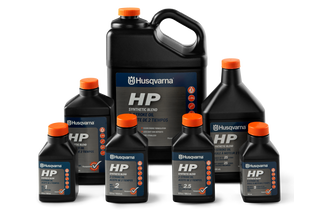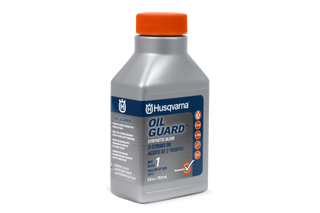How to mix 2-stroke fuel for chainsaws, trimmers & leaf blowers
Unlike a car engine, one of the unique features of a two-stroke engine is that they do not have an internal oil reservoir. Instead, two-stroke engines require the owner to mix oil into the fuel at a predetermined ratio in order to ensure the engine receives adequate lubrication during operation. In this guide, we'll explain how to do that.
Two-stroke engine lubrication basics
The first true two-stroke engines (also known as two-cycle engines) were introduced more than a century ago and used to power motorcycles. These days, you’ll find two-stroke engines in all kinds of gas equipment, such as chainsaws, string trimmers, hedge trimmers and leaf blowers, largely because two-stroke engines have fewer moving parts, generate less heat and are in many ways more efficient for their size.
Technically speaking, when it comes to engine lubrication, the difference between a two-stroke and four-stroke engine is pretty straightforward:
- A two-stroke engine has no valve train, timing gears, cams or pushrods, so only the inside the combustion chamber needs to be lubricated. This can be achieved by simply mixing oil into the fuel.
- A four-stroke engine does have all of those parts, so oil must be circulated everywhere to keep the machine running.
Start off with a clean gas can
Did you know the leading cause of contaminated fuel is dirty fuel containers? For this reason, it is essential that you store fresh gas in a clean container specifically designed to carry fuel.
Choosing the right unleaded fuel & right two-stroke oil
Husqvarna's two-stroke oil is specially designed for use in Husqvarna products. Husqvarna two-stroke engines require a two-stroke oil that's designed and formulated for high performance, air-cooled two-stroke engines. That's why the best bet is to always go with Husqvarna's premium lubricants including our premixed XP+ fuel and oil.
If not using a premixed fuel and oil blend, you should always use unleaded ethanol-free gas for your outdoor power equipment. Learn more about why ethanol fuel is bad for your small engine equipment.
Here are some additional tips for choosing the best two-stroke oil for blowers, trimmers, chainsaws and more:
- As a general warning, never use two-stroke oil intended for water-cooled engines in a non water-cooled engine. This oil is sometimes referred to as outboard oil (rated TCW). Also, never use oil intended for four-stroke engines, such as motor vehicle oil.
- Mineral oils usually cost less than synthetics and are great for engine lubrication. While these oils are made from a natural petroleum base and do a fair job of cleaning and filtering engine contaminants, they can leave behind heavier deposits than their synthetic counterparts. Over time, you may end up with burnt carbon or gummy residue buildup on the piston, which can lead to more maintenance and compromised performance. Sometimes manufacturers mix in additives that help improve combustibility.
- Full synthetic oils demonstrate superior combustion characteristics on top of delivering great lubrication. With little to none of the mess that a petroleum-based oil can leave behind, leaving you with a much cleaner engine. They’re generally formed from a mineral base, with additives like octane enhancers, detergents and stabilizers to help burn cleaner than other engine oils and produce less smoke.
- Semi-synthetic oils meet you in the middle. They’re primarily comprised of high-quality mineral oil. But mixed with additives and synthetic polymers to deliver a cleaner burn than a strictly petroleum based product. Semi-synthetics cost less than full synthetic oils, offer good combustion properties and give you better lubrication than you’d get from a standard, low quality mineral oil.
Two-stroke fuel ratios
It’s important to get your ratios right when mixing fuel with two-stroke fuel oil:
- Too much oil, and your engine may struggle to start or run, generate carbon buildup, blow clouds of smoke and generally perform poorly.
- On the other hand, if you add too little oil, your engine may sustain internal damage and overheat.
The correct mixing ratio for your Husqvarna is detailed in your product's owner's manual. But as a general guide, a fuel-to-oil ratio of 50:1 is recommended for Husqvarna products up to and including 75cc. That comes out to 2.5 fluid ounces of oil per 1 gallon of gas.
For high-performance fuel that requires no mixing, you can always choose ethanol-free Husqvarna XP+ premixed fuel and oil.
Steps for mixing two-stroke fuel and oil
- Use a clean, airtight container intended for fuel. Not only will doing so prolong the shelf life of your fuel mix, but it will help prevent permeation and evaporation.
- Always start by filling the container with half the amount of the gas to be used.
- Add the entire amount of oil.
- Gently shake to mix the fuel and oil together.
- Add in the remaining amount of gas.
Top tips for mixing two-stroke fuel
- It's best to use a separate gas can for storing your two-stroke fuel and oil mix. That way you won't ever confuse it with the regular fuel used in four-stroke engines, or vice-versa.
- Avoid storing mixed two-stroke fuel for more than one month.
- If you do need to prolong the life of your mixed two-stroke fuel, there are fuel stabilizers available that can be added which may extend the shelf life up to twelve months.
- Always clean your gas cap and the surrounding area before filling up to prevent dirt and debris from falling into your equipment's gas tank.
- Don’t leave premixed two-stroke fuel in any tool for an extended period of time. Drain tanks and run your tool out of fuel before putting it away for the season.
- You can always consult your nearest Husqvarna dealer if you are unsure about the correct use of your two-stroke product.














